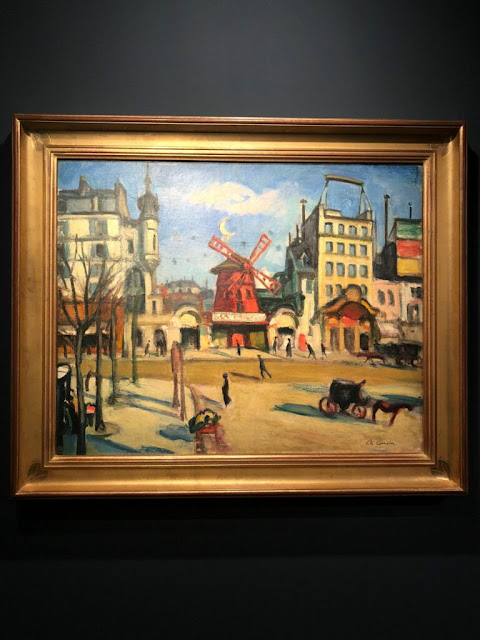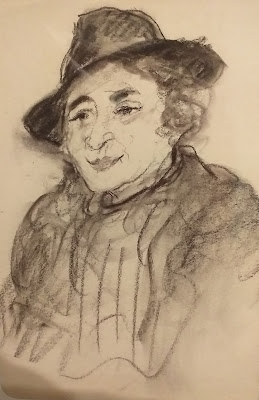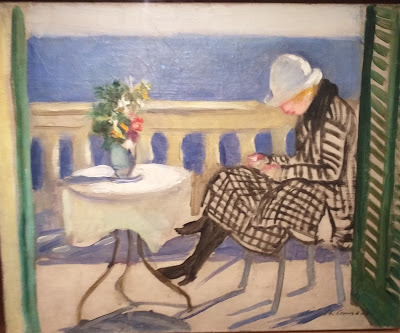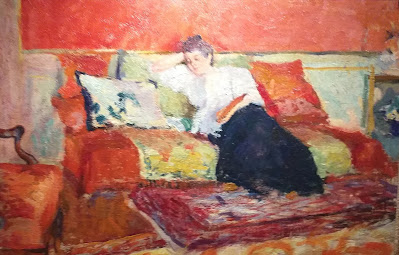The Montmartre Museum is a haven of peace in busy, touristy Montmartre. Its summer 2022 show is devoted to Charles Camoin (1879-1965). Born in Marseille and known as a Fauvist, his brightly coloured paintings are well worth discovering. Camoin is one of the many artists who lived in a studio in the building which is now the Museum.
 |
| Port de Cassis (Cassis port) 1904 private collection |
Camoin's portrait of his mother, below, painted when he was not yet 20, has a feeling of the Nabi artists, like Vuillard, with its sense of intimacy and decorative colourful patches. Marie Camoin (1848-1930) was an artist in her own right. She is holding her palette as she rests on the sofa. When this painting came into the public collection in 1935, it was entitled "Woman with fan"!
 |
| La promenade au parc (Walk in the park) ca 1902 private collection |
As a student in Paris, Camoin was taught for a short time by professor Gustave Moreau, who encouraged his pupils to express themselves through colour. Matisse was a fellow pupil at the Beaux Arts, as were Manguin and Marquet. Moreau's class produced some wonderful artists.
Camoin became good friends with Marquet and Matisse (10 years his elder); they shared studios and models and travelled around Paris or elsewhere together to paint landscapes.
 |
| Le Pont des Arts vu du Pont-Neuf (Arts bridge seen from Pont-neuf) 1904 |
The exhibition includes a brilliantly coloured Matisse:
.jpg) |
| Matisse: Liseuse en robe violette (Woman reading wearing a purple dress) 1898 Beaux Arts, Reims |
It is unfortunate for Camoin that he has been overshadowed by Matisse's genius; he has a powerful personality, shown in this work lent by the Le Havre Museum:
 |
| Jeune Créole (Young Creole) 1904 |
 |
| Camoin: Portrait of Albert Marquet 1904/5 |
Charles Camoin's father had a painting and decorating company in Marseille, where Charles was born in 1879, the youngest of 4 children. Marseille was where he did his first training at the Arts School.
From age 18, his life was spent largely in Paris, but with frequent trips to the South.
While in Paris in the 20s, he painted a fellow artist's small house in the 'Maquis' or scrubland of Montmartre:
 |
| La Maison de Paco Durrio, à Montmartre (Paco Durrio's House, Montmartre) 1927 |
Colour is paramount in Camoin's late painting of another Montmartre scene:
 |
| Printemps, Square St-Pierre à Montmartre (Spring, St-Pierre's Square, Montmartre) 1945 |
 |
| Maisons à Montmartre (Houses in Montmartre) ca 1908 |
This solid, colourful Montmartre scene has been lent by the Presidential gallery.
One section of the exhibition is devoted to Camoin's nude paintings. Echoes of Renoir...
And in Camoin's groups of nudes in a pastoral setting, echoes of Cézanne...
A rather crude nude, if you will forgive the expression, full of modern realism is on loan from the Museum of Modern Art in Paris:
 |
| La Saltimbanque au repos (The Entertainer at rest) 1905 |
The Commissioners of this exhibition Assia Quesnel and Saskia Ooms, point out that this realistic modern portrayal shows a woman who is erotic and assertive at the same time. Camoin wanted to get away from academic treatment of the nude and give us the truth.
In the early years of the century, Camoin travelled to Corsica with a woman painter companion Emilie Charmy. They painted alongside each other the brilliant scenes on the Mediterranean island.
The poster for the present show uses Camoin's view of pine trees painted in Corsica:
During a stay in Tangiers with Matisse in 1912/13, Camoin wrote that his painting was going well. But then he went through a time of self doubt just before World War 1, to the point of destroying all the works in his studio (80) - slashing them to pieces and throwing them in the wood stove or the garbage bin. Fortunately the neighbourhood ragpicker, who had an eye for quality, fished some out and fifteen have since been restored. For example this self portrait:
 |
| Self portrait 1910 private collection |
A second pieced-together picture portrays an icon of Montmartre- the Moulin Rouge:
 |
| Le Moulin-Rouge aux fiacres (The Moulin Rouge with cabs) 1910 Beaux-Arts, Menton |
A third painting which Camoin tried to destroy is reminiscent of Gauguin's style:
 |
| L'Indochinoise (The Indochinese woman) ca1905 private collection |
Some of the sketches Camoin did during the war are on show, for example his self portrait as soldier:
Camoin, as several of his fellow artists, was affected to the Camouflage division of the army.
Signac bought Camoin's view of a Marseille street, shown at the Salon des Indépendants in 1905- it figures in the present exhibition:
 |
| Marseille, rue Bouterie (Bouterie Street) 1905 Private Collection |
Camoin was a familiar of Montmartre, but met celebrities like Colette or painter friends such as Signac and Bonnard when down in St Tropez.
 |
| Colette ca1945 (pastel and pencil) private collection |
 |
| La Croisée des Chemins à Ramatuelle (The crossing of the roads at Ramatuelle) 1957 private collection |
 |
| Le Printemps (Spring) 1921 private collection |
In 1920, aged 41, he married Charlotte Prost- 'Lola'. Camoin captures the idyllic life of Mediterranean climes in a portrait of Lola:
 |
| Lola sur la terrasse (Lola on the terrace) 1920 Private Collection |
Camoin is on show until 11th September 2022.
Life and art goes on in Montmartre and the Museum is planning a new exhibition in October 2022 centred around Picasso's mistress Fernande Olivier, then in March 2023 an exhibition of women Surrealist painters.
The Montmartre Museum, 12 rue Cortot, Paris 18e, is open every day except Tuesday from 10am to 6pm October to March and until 7pm from April to September. Entrance: 14€ Metro: Lamarck Caulaincourt. It's worth a visit for the garden alone!






Comments
Post a Comment